Cisco Certification Exam Prep Materials
Cisco CCNA Exam Prep Material Download
Cisco CCT Exam Prep Material Download
- Cisco 010-151 Dumps PDF
- Cisco 100-490 Dumps PDF
- Cisco 100-890 Dumps PDF
- Tips: Beginning February 10, the CCT Certification 500-150 FLDTEC v1.0 exam will replace the 100-490, 010-151, and 100-890 exams.
Cisco CyberOps Exam Prep Material Download
Cisco DevNet Exam Prep Material Download
Cisco CCNP Exam Prep Material Download
- Cisco 300-410 Dumps PDF
- Cisco 300-415 Dumps PDF
- Cisco 300-420 Dumps PDF
- Cisco 300-425 Dumps PDF
- Cisco 300-430 Dumps PDF
- Cisco 300-435 Dumps PDF
- Cisco 300-440 Dumps PDF
- Cisco 300-510 Dumps PDF
- Cisco 300-515 Dumps PDF
- Cisco 300-535 Dumps PDF
- Cisco 300-610 Dumps PDF
- Cisco 300-615 Dumps PDF
- Cisco 300-620 Dumps PDF
- Cisco 300-630 Dumps PDF
- Cisco 300-635 Dumps PDF
- Cisco 300-710 Dumps PDF
- Cisco 300-715 Dumps PDF
- Cisco 300-720 Dumps PDF
- Cisco 300-725 Dumps PDF
- Cisco 300-730 Dumps PDF
- Cisco 300-735 Dumps PDF
- Cisco 300-810 Dumps PDF
- Cisco 300-815 Dumps PDF
- Cisco 300-820 Dumps PDF
- Cisco 300-835 Dumps PDF
Cisco CCIE Exam Prep Material Download
- Cisco 350-401 Dumps PDF
- Cisco 350-501 Dumps PDF
- Cisco 350-601 Dumps PDF
- Cisco 350-701 Dumps PDF
- Cisco 350-801 Dumps PDF
Cisco CCDE Exam Prep Material Download
Cisco Other Exam Prep Material Download
- Cisco 500-052 Dumps PDF
- Cisco 500-210 Dumps PDF
- Cisco 500-220 Dumps PDF
- Cisco 500-420 Dumps PDF
- Cisco 500-442 Dumps PDF
- Cisco 500-444 Dumps PDF
- Cisco 500-470 Dumps PDF
- Cisco 500-490 Dumps PDF
- Cisco 500-560 Dumps PDF
- Cisco 500-710 Dumps PDF
- Cisco 700-150 Dumps PDF
- Cisco 700-750 Dumps PDF
- Cisco 700-760 Dumps PDF
- Cisco 700-765 Dumps PDF
- Cisco 700-805 Dumps PDF
- Cisco 700-821 Dumps PDF
- Cisco 700-826 Dumps PDF
- Cisco 700-846 Dumps PDF
- Cisco 700-905 Dumps PDF
- Cisco 820-605 Dumps PDF
Fortinet Exam Dumps
fortinet nse4_fgt-6.4 dumps (pdf + vce)
fortinet nse4_fgt-6.2 dumps (pdf + vce)
fortinet nse5_faz-6.4 dumps (pdf + vce)
fortinet nse5_faz-6.2 dumps (pdf + vce)
fortinet nse5_fct-6.2 dumps (pdf + vce)
fortinet nse5_fmg-6.4 dumps (pdf + vce)
fortinet nse5_fmg-6.2 dumps (pdf + vce)
fortinet nse6_fml-6.2 dumps (pdf + vce)
fortinet nse6_fnc-8.5 dumps (pdf + vce)
fortinet nse7_efw-6.4 dumps (pdf + vce)
fortinet nse7_efw-6.2 dumps (pdf + vce)
fortinet nse7_sac-6.2 dumps (pdf + vce)
fortinet nse7_sdw-6.4 dumps (pdf + vce)
fortinet nse8_811 dumps (pdf + vce)
Valid Microsoft AZ-120 questions shared by Pass4itsure for helping to pass the Microsoft AZ-120 exam! Get the newest Pass4itsure Microsoft AZ-120 exam dumps with VCE and PDF here:https://www.pass4itsure.com/az-120.html (111 Q&As Dumps).
[Free PDF] Microsoft AZ-120 pdf https://drive.google.com/file/d/1T3MYYuBl9Ji2VkgKz0w99YwtGYEidO14/view?usp=sharing
Suitable for AZ-120 complete Microsoft learning pathway
The content is rich and diverse, and learning will not become boring. You can learn in multiple ways through the Microsoft AZ-120 exam.
- Download
- Answer practice questions, the actual Microsoft AZ-120 test
Microsoft AZ-120 Planning and Administering Microsoft Azure for SAP Workloads
Free Microsoft AZ-120 dumps download
[PDF] Free Microsoft AZ-120 dumps pdf download https://drive.google.com/file/d/1T3MYYuBl9Ji2VkgKz0w99YwtGYEidO14/view?usp=sharing
Pass4itsure offers the latest Microsoft AZ-120 practice test free of charge 1-13
QUESTION 1
You have an on-premises SAP environment that uses AIX servers and IBM DB2 as the database platform.
You plan to migrate SAP to Azure. In Azure, the SAP workloads will use Windows Server and Microsoft SQL Server as
the database platform.
What should you use to export from DB2 and import the data to SQL Server?
A. R3load
B. Azure SQL Data Warehouse
C. SQL Server Management Studio (SSMS)
D. R3trans
Correct Answer: C
To migrate DB2 databases to SQL Server, you must connect to the DB2 database that you want to migrate. When you
connect, SSMA obtains metadata about all DB2 schemas, and then displays it in the DB2 Metadata Explorer pane.
References: https://docs.microsoft.com/en-us/sql/ssma/db2/connecting-to-db2-database-db2tosql?view=sql-serverver15 https://docs.microsoft.com/en-us/biztalk/adapters-and-accelerators/adapter-sap/import-sap-data-using-sql-servermanagement-studio
QUESTION 2
HOTSPOT
Your on-premises network contains SAP and non-SAP applications.
You have JAVA-based SAP systems that use SPNEGO for single-sign on (SSO) authentication.
Your external portal uses multi-factor authentication (MFA) to authenticate users.
You plan to extend the on-premises authentication features to Azure and to migrate the SAP applications to Azure.
For each of the following statements, select Yes if the statement is true. Otherwise, select No.
NOTE: Each correct selection is worth one point.
Hot Area:
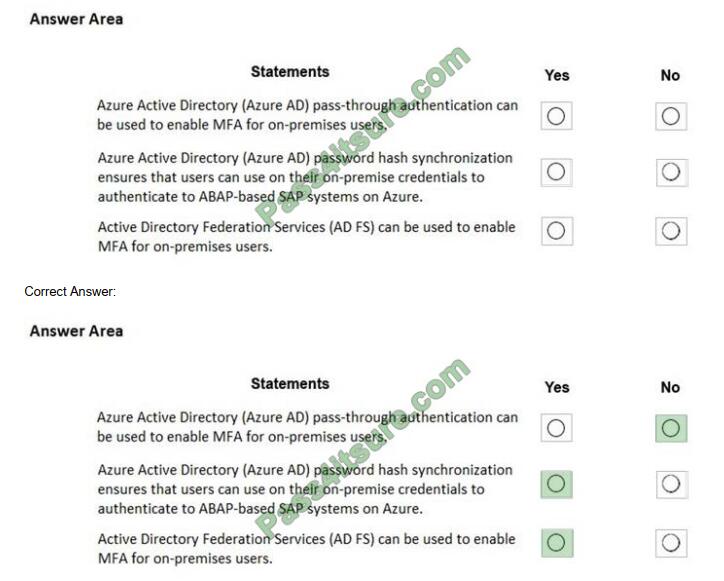
Box 1: No
Need AD FS for MFA. See box 3.
Note: Azure Active Directory (Azure AD) Pass-through Authentication allows your users to sign in to both on-premises
and cloud-based applications using the same passwords. This feature is an alternative to Azure AD Password Hash
Synchronization (see Box 2).
Box 2: Yes
Password hash synchronization is one of the sign-in methods used to accomplish hybrid identity. Azure AD Connect
synchronizes a hash, of the hash, of a users password from an on-premises Active Directory instance to a cloud-based
Azure AD instance.
Password hash synchronization is an extension to the directory synchronization feature implemented by Azure AD
Connect sync. You can use this feature to sign in to Azure AD services like Office 365. You sign in to the service by
using the same password you use to sign in to your on-premises Active Directory instance.
Box 3: Yes
If your organization is federated with Azure AD, you can use Azure Multi-Factor Authentication to secure AD FS
resources, both on-premises and in the cloud. Azure MFA enables you to eliminate passwords and provide a more
secure way to
authenticate.
References:
https://docs.microsoft.com/en-us/azure/active-directory/hybrid/whatis-phs
https://docs.microsoft.com/en-us/windows-server/identity/ad-fs/operations/configure-ad-fs-and-azure-mfa
QUESTION 3
You plan to deploy an SAP environment on Azure that will use Azure Availability Zones. Which load balancing solution
supports the deployment?
A. Azure Basic Load Balancer
B. Azure Standard Load Balancer
C. Azure Application Gateway v1 SKU
Correct Answer: B
When you deploy Azure VMs across Availability Zones and establish failover solutions within the same Azure region,
some restrictions apply:
You can\\’t use an Azure Basic Load Balancer to create failover cluster solutions based on Windows Server Failover
Clustering or Linux Pacemaker. Instead, you need to use the Azure Standard Load Balancer SKU.
References:
https://docs.microsoft.com/en-us/azure/virtual-machines/workloads/sap/sap-ha-availability-zones
QUESTION 4
You plan to deploy SAP application servers that run Windows Server 2016.
You need to use PowerShell Desired State Configuration (DSC) to configure the SAP application server once the
servers are deployed.
Which Azure virtual machine extension should you install on the servers?
A. the Azure DSC VM Extension
B. the Azure virtual machine extension
C. the Azure Chef extension
D. the Azure Enhanced Monitoring Extension for SAP
Correct Answer: A
The Azure Desired State Configuration (DSC) VM Extension is updated as-needed to support enhancements and new
capabilities delivered by Azure, Windows Server, and the Windows Management Framework (WMF) that includes
Windows PowerShell.
References: https://docs.microsoft.com/en-us/powershell/scripting/dsc/getting-started/azuredscexthistory
QUESTION 5
HOTSPOT
You are designing the backup for an SAP database.
You have an Azure Storage account that is configured as shown in the following exhibit.
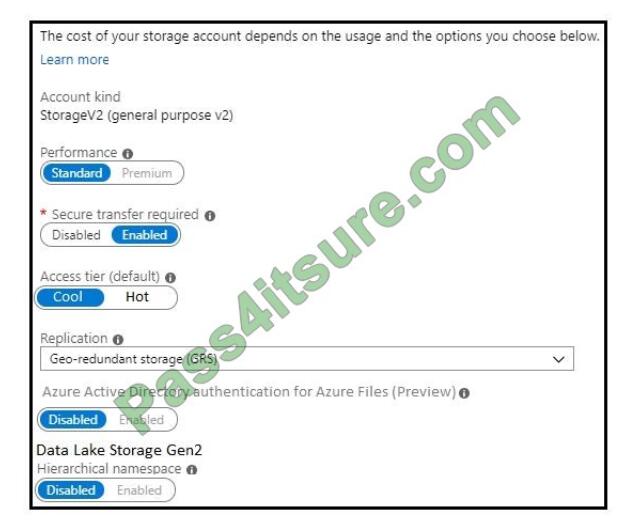 Use the drop-down menus to select the answer choice that completes each statement based on the information
Use the drop-down menus to select the answer choice that completes each statement based on the information
presented in the graphic.
NOTE: Each correct selection is worth one point.
Hot Area:
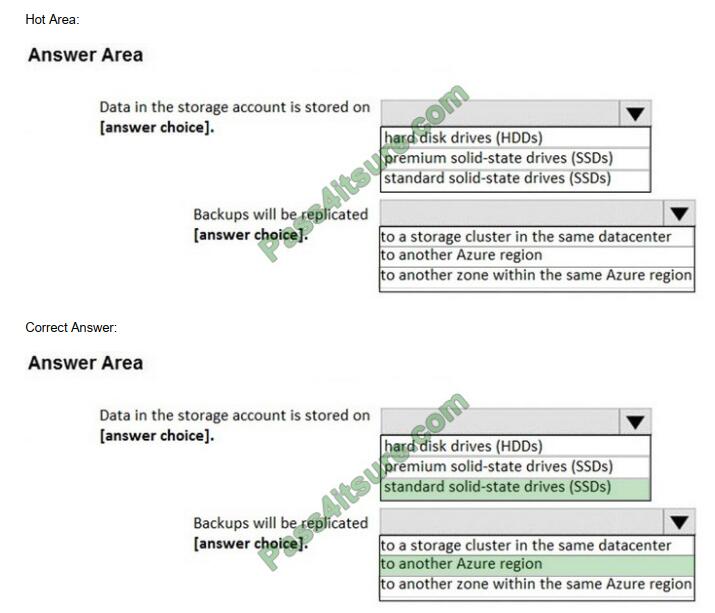
Box 1: standard solid-state drives (SSDs)
Standard SSD Managed Disks, a low-cost SSD offering, are optimized for test and entry-level production workloads
requiring consistent latency.
Box 2: to another Azure region
Geo-redundant storage (GRS) copies your data synchronously three times within a single physical location in the
primary region using LRS. It then copies your data asynchronously to a single physical location in a secondary region
that is
hundreds of miles away from the primary region.
References:
https://azure.microsoft.com/en-us/pricing/details/managed-disks/
QUESTION 6
You plan to deploy an SAP environment on Azure.
You plan to store all SAP connection strings securely in Azure Key Vault without storing credentials on the Azure virtual
machines that host SAP.
What should you configure to allow the virtual machines to access the key vault?
A. Azure Active Directory (Azure AD) Privilege Identity Manager (PIM)
B. role-based access control (RBAC)
C. a Managed Service Identity (MSI)
D. the Custom Script Extension
Correct Answer: C
To reference a credential stored in Azure Key Vault, you need to:
1.
Retrieve data factory managed identity
2.
Grant the managed identity access to your Azure Key Vault
3.
Create a linked service pointing to your Azure Key Vault.
4.
Create data store linked service, inside which reference the corresponding secret stored in key vault.
References: https://docs.microsoft.com/bs-latn-ba/azure/data-factory/store-credentials-in-key-vault
QUESTION 7
DRAG DROP
You are validating an SAP HANA on Azure (Large Instances) deployment.
You need to ensure that sapconf is installed and the kernel parameters are set appropriately for the active profile.
How should you complete the commands? To answer, drag the appropriate values to the correct targets. Each value
may be used once, more than once, or not at all. You may need to drag the split bar between panes or scroll to view
content.
NOTE: Each correct selection is worth one point.
Select and Place:
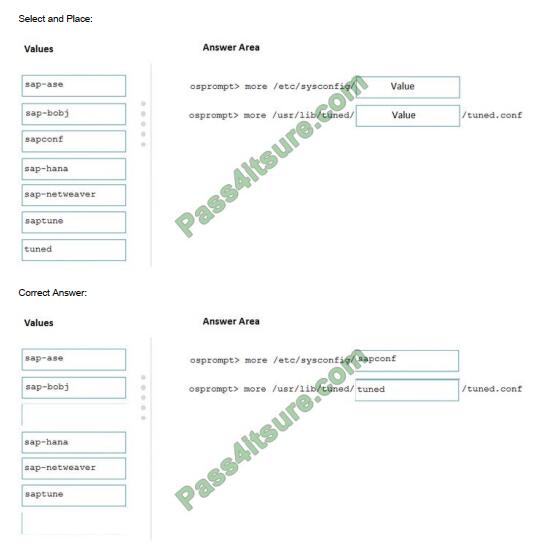
Box 1: sapconf The configuration is split into two parts: /etc/sysconfig/sapconf /usr/lib/tuned//tuned.conf
Box 2: tuned
References: https://www.suse.com/c/sapconf-a-way-to-prepare-a-sles-system-for-sap-workload-part-2/
QUESTION 8
You plan to migrate an SAP ERP Central Component (SAP ECC) production system to Azure.
You are reviewing the SAP EarlyWatch Alert report for the system.
You need to recommend sizes for the Azure virtual machines that will host the system.
Which two sections of the report should you review? Each correct answer presents a complete solution.
NOTE: Each correct selection is worth one point.
A. Hardware Capacity
B. Patch Levels under SAP Software Configuration
C. Hardware Configuration under Landscape
D. Database and ABAP Load Optimization
E. Data Volume Management
Correct Answer: AD
It is important to note that there are 2 types of data collected for Hardware Capacity.
Performance Data – e.g. CPU and Memory utilization data.
Hardware Capacity data shown in the EWA is measuring CPU and Memory utilization data. This is known as
Performance Data.
Configuration Data – e.g. OS information, CPU type.
It is also collecting system information about the host such as hardware manufacturer, CPU type etc. This is known as
Configuration Data. Incorrect Answers:
E: Data Volume Management focuses on whether the collection of DVM content for the EarlyWatch Alert report is not
performed, not activated, or not possible because the SAP Solution Manager system does not meet the technical
requirements.
References: https://wiki.scn.sap.com/wiki/display/SM/Hardware+Capacity+Checks+in+EWA
QUESTION 9
You deploy an SAP environment on Azure by following the SAP workload on Azure planning and deployment checklist.
You need to verify whether Azure Diagnostics is enabled.
Which cmdlet should you run?
A. Get-AzureVMAvailableExtension
B. Get-AzVmDiagnosticsExtension
C. Test-AzDeployment
D. Test-VMConfigForSAP
Correct Answer: B
The Get-AzVMDiagnosticsExtension cmdlet gets the settings of the Azure Diagnostics extension on a virtual machine.
Incorrect Answers:
D: You can check the configuration of a virtual machine by calling the Test-VMConfigForSAP_GUI commandlet.
References: https://docs.microsoft.com/en-us/powershell/module/az.compute/get-azvmdiagnosticsextension
QUESTION 10
HOTSPOT
For each of the following statements, select Yes if the statement is true. Otherwise, select No.
NOTE: Each correct selection is worth one point.
Hot Area: 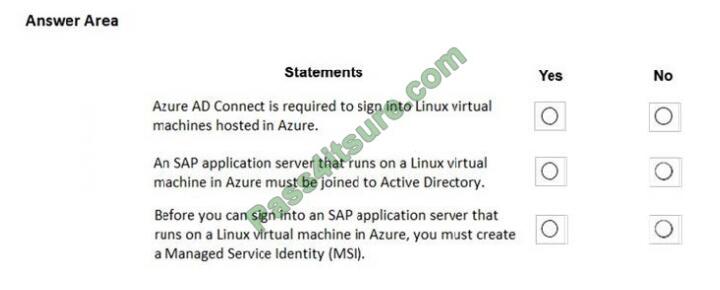
Correct Answer:
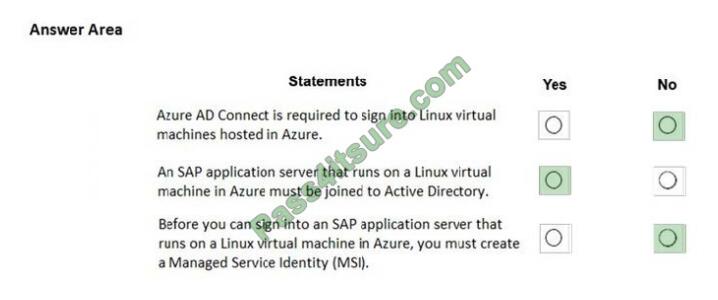
Box 1: No
To log in to a Linux VM with Azure AD credentials, install the Azure Active Directory login VM extension.
Note: Azure AD Connect is the Microsoft tool designed to meet and accomplish your hybrid identity goals.
Box 2: Yes
If you deploy SAP VMs in a cross-premises scenario, where on-premises Active Directory and DNS are extended in
Azure, it is expected that the VMs are joining an on-premises domain.
Box 3: No
References:
https://docs.microsoft.com/en-us/azure/virtual-machines/workloads/sap/deployment-guide
QUESTION 11
HOTSPOT
You need to provide the Azure administrator with the values to complete the Azure Resource Manager template.
Which values should you provide for diskCount, StorageAccountType, and domainName? To answer, select the
appropriate options in the answer area.
NOTE: Each correct selection is worth one point.
Hot Area:
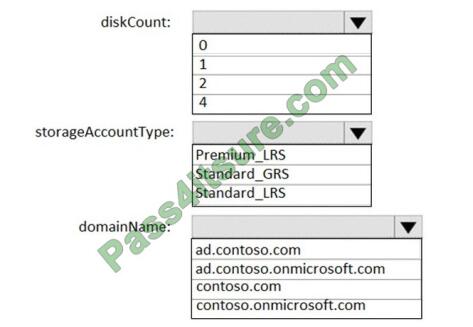
Correct Answer:
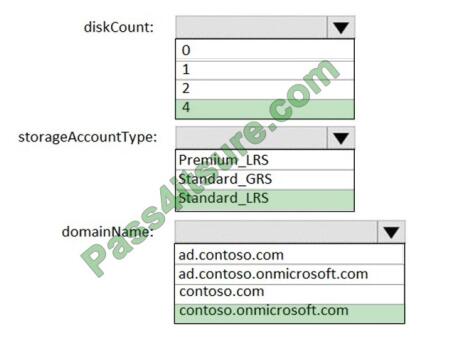
Box 1: 4
Scenario: the Azure Resource Manager template that will be used to provision the production application servers.
Ensure that each production application server has four 1-TB data disks.
Box 2: Standard_LRS
Scenario: Minimize costs whenever possible.
Box 3: contoso.onmicrosoft.com
The network contains an on-premises Active Directory domain named ad.contoso.com.
The Initial domain: The default domain (onmicrosoft.com) in the Azure AD Tenant. For example,
contoso.onmicrosoft.com.
References:
https://docs.microsoft.com/en-us/azure/active-directory/hybrid/plan-connect-userprincipalname
QUESTION 12
You are migrating SAP to Azure. The ASCS application servers are in one Azure zone, and the SAP database server in
in a different Azure zone. ASCS/ERS is configured for high availability.
During performance testing, you discover increased response times in Azure, even though the Azure environment has
better computer and memory configurations than the on-premises environment.
During the initial analysis, you discover an increased wait time for Enqueue.
What are three possible causes of the increased wait time? Each correct answer presents a complete solution.
NOTE: Each correct selection is worth one point.
A. a missing Enqueue profile
B. disk I/O during Enqueue backup operations
C. misconfigured load balancer rules and health check probes for Enqueue and ASCS
D. active Enqueue replication
E. network latency between the database server and the SAP application servers
Correct Answer: CDE
E: The network latency across Availability Zones is not the same in all Azure regions. In some cases, you can deploy
and run the SAP application layer across different zones because the network latency from one zone to the active
DBMS VM is acceptable. But in some Azure regions, the latency between the active DBMS VM and the SAP application
instance, when deployed in different zones, might not be acceptable for SAP business processes.
References: https://docs.microsoft.com/en-us/azure/virtual-machines/workloads/sap/sap-ha-availability-zones
QUESTION 13
Note: This question is part of a series of questions that present the same scenario. Each question in the series contains
a unique solution that might meet the stated goals. Some question sets might have more than one correct solution,
while
others might not have a correct solution.
After you answer a question in this section, you will NOT be able to return to it. As a result, these questions will not
appear in the review screen.
You deploy SAP HANA on Azure (Large Instances).
You need to back up the SAP HANA database to Azure.
Solution: You configure DB13 to back up directly to a local disk.
Does this meet the goal?
A. Yes
B. No
Correct Answer: B
Summarize:
[Q1-Q13] Free Microsoft AZ-120 pdf download https://drive.google.com/file/d/1T3MYYuBl9Ji2VkgKz0w99YwtGYEidO14/view?usp=sharing
Share all the resources: Latest Microsoft AZ-120 practice questions, latest Microsoft AZ-120 pdf dumps. Latest updated Microsoft AZ-120 dumps https://www.pass4itsure.com/az-120.html Study hard and practices a lot. This will help you prepare for the Microsoft AZ-120 exam. Good luck!
Related
Discover more from Exampass: Collection of Cisco (CCNA, CCNP, Meraki Solutions Specialist, CCDP...) exam questions and answers from Pass4itsure
Subscribe to get the latest posts sent to your email.
Written by Ralph K. Merritt
We are here to help you study for Cisco certification exams. We know that the Cisco series (CCNP, CCDE, CCIE, CCNA, DevNet, Special and other certification exams are becoming more and more popular, and many people need them. In this era full of challenges and opportunities, we are committed to providing candidates with the most comprehensive and comprehensive Accurate exam preparation resources help them successfully pass the exam and realize their career dreams. The Exampass blog we established is based on the Pass4itsure Cisco exam dump platform and is dedicated to collecting the latest exam resources and conducting detailed classification. We know that the most troublesome thing for candidates during the preparation process is often the massive amount of learning materials and information screening. Therefore, we have prepared the most valuable preparation materials for candidates to help them prepare more efficiently. With our rich experience and deep accumulation in Cisco certification, we provide you with the latest PDF information and the latest exam questions. These materials not only include the key points and difficulties of the exam, but are also equipped with detailed analysis and question-answering techniques, allowing candidates to deeply understand the exam content and master how to answer questions. Our ultimate goal is to help you study for various Cisco certification exams, so that you can avoid detours in the preparation process and get twice the result with half the effort. We believe that through our efforts and professional guidance, you will be able to easily cope with exam challenges, achieve excellent results, and achieve both personal and professional improvement. In your future career, you will be more competitive and have broader development space because of your Cisco certification.
Categories
2025 Microsoft Top 20 Certification Materials
- Microsoft Azure Administrator –> az-104 dumps
- Microsoft Azure Fundamentals –> az-900 dumps
- Data Engineering on Microsoft Azure –> dp-203 dumps
- Developing Solutions for Microsoft Azure –> az-204 dumps
- Microsoft Power Platform Developer –> pl-400 dumps
- Designing and Implementing a Microsoft Azure AI Solution –> ai-102 dumps
- Microsoft Power BI Data Analyst –> pl-300 dumps
- Designing and Implementing Microsoft DevOps Solutions –> az-400 dumps
- Microsoft Azure Security Technologies –> az-500 dumps
- Microsoft Cybersecurity Architect –> sc-100 dumps
- Microsoft Dynamics 365 Fundamentals Customer Engagement Apps (CRM) –> mb-910 dumps
- Microsoft Dynamics 365 Fundamentals Finance and Operations Apps (ERP) –> mb-920 dumps
- Microsoft Azure Data Fundamentals –> dp-900 dumps
- Microsoft 365 Fundamentals –> ms-900 dumps
- Microsoft Security Compliance and Identity Fundamentals –> sc-900 dumps
- Microsoft Azure AI Fundamentals –> ai-900 dumps
- Microsoft Dynamics 365: Finance and Operations Apps Solution Architect –> mb-700 dumps
- Microsoft 365 Certified: Enterprise Administrator Expert –> ms-102 dumps
- Microsoft 365 Certified: Collaboration Communications Systems Engineer Associate –> ms-721 dumps
- Endpoint Administrator Associate –> md-102 dumps

